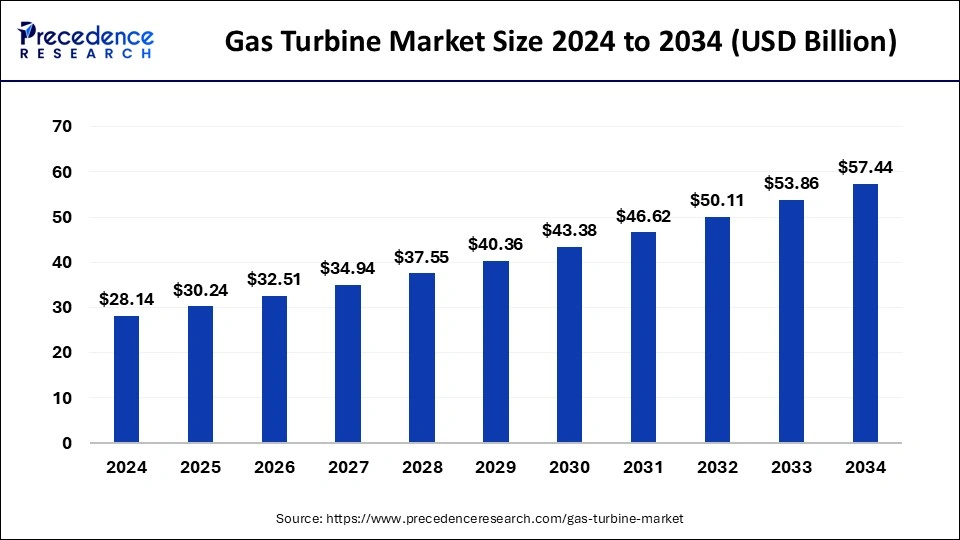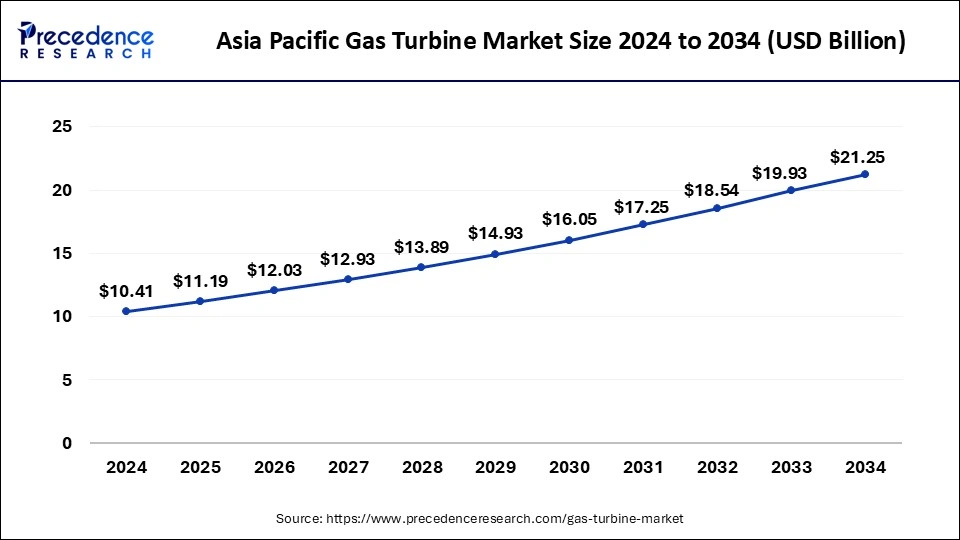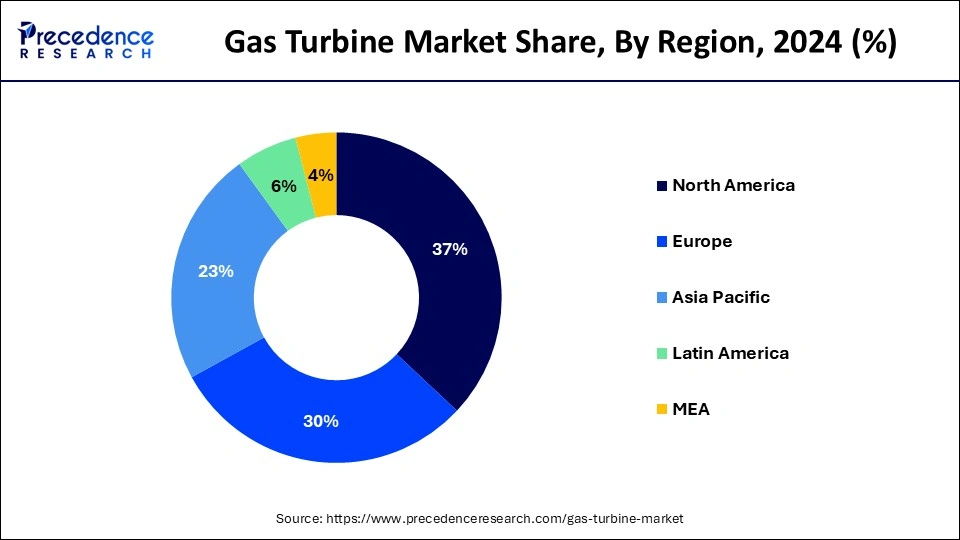List of Contents
Gas Turbine Market Size and Forecast 2025 to 2034
The global gas turbine market size was estimated at USD 28.14 billion in 2024 and is predicted to increase from USD 30.24 billion in 2025 to approximately USD 57.44 billion by 2034, expanding at a CAGR of 7.4% from 2025 to 2034.

Gas Turbine MarketKey Takeaways
- Asia Pacific has held approximately 37% of the total revenue share in 2024.
- By capacity, the>200 MW segment had a significant revenue share of 66% in 2024.
- By technology, the combined cycle turbines sector has the highest revenue share 74% in 2024.
- By end use, the power & utility segment held a revenue share of over 82% in 2024.
- The aero-derivative segment is growing at 9% of CAGR from 2025 to 2034.
Asia Pacific Gas Turbine Market Size and Growth 2025 To 2034
The Asia Pacific gas turbine market size was valued at USD 10.41billion in 2024 and is expected to be worth around USD 21.25 billion by 2034, growing at a CAGR of 8% from 2025 to 2034.

The gas turbine industry in Asia Pacific is predicted to surpass 10 GW annual installations by 2034. Easy approachability of raw material and constant incorporation of technologically advanced turbines are major factors rushing the product saturation. Escalating focus toward CCGT power technology plus upward applicability of gas-powered systems through drilling and extraction methods will promote product demand further. Middle East and Africa is projected to appear as another significant market in terms of capacity additions and orders. Cumulative demand can be credited to expanding inclination to gas-fired combined cycle plants in the local oil and gas sector.
The EU policymakers deliberate gas turbines more than a connecting technology to attain the 2034 targets till other technologies are developed. It is expected to propel the demand for gas turbines throughout the estimate period. Though, the release of methane and other harmful gases can pose a challenge to this growth in near future.
Asia Pacific is still a budding market nonetheless forceful infrastructure expansion commenced by governments is anticipated to offer the market a momentous boost. India is also growing its focus on the utilization of cleaner resources. Further, China's reliance on coal is foreseen to decline over the upcoming years, alongside its energy mix principally preferring clean energy resources.
China: China leads the Asia-Pacific gas turbine market with a 38.1% share as of 2023. The shift from coal-fired plants to natural gas infrastructure is propelled by pollution concerns and green policy frameworks.
Japan: Japan continues to expand its natural gas capacity to reduce dependency on nuclear energy post-Fukushima. Gas turbines play a central role in its energy diversification strategy.
India: India is witnessing moderate growth in this segment, focusing on industrial and residential energy use through LNG imports. Though facing competition from steam turbines, its interest in hydrogen-compatible turbines is growing

Growing concerns for GHG emissions in accordance with severe government regulations for the implementation of gas fired turbines over conventional power generating units is expected to propel the growth of gas turbine market. Growing energy demand in emerging countries as well as constant acceptance of renewables than traditional fuels is predicted to further reinforce the product integration. Technology enhancement has led upsurge in the production of shale gas and plans of numerous nations to phase out coal-based power generation and substitute them with the gas-fired power plant, is expected to flourish the market growth during years to come. Nevertheless, growing renewable deployment on account of superior competence of renewable-based power generation may hamper growth of gas turbine market in the coming years.
It is anticipated that in the coming years, electricity demand may grow by closely one-third of the current demand. Main gas producing regions including the U.S., Middle East, and Russia are observing a foremost revamp in their electricity generation groundwork to rapidly follow gas-based power generation. Noteworthy installations are also observed in Latin America, Southeast Asia, and Africa. As a result of these advancements, demand for gas turbine may increase in these regions during forecast period.
United States: The U.S. is the dominant force in the region, accounting for over 80% of the North American gas turbine market. Natural gas-powered plants generate the country's electricity, underscoring the nation's reliance on gas turbines for energy security and emissions control.
Canada: Holding roughly of the regional market, Canada is transitioning from coal to cleaner gas-powered solutions, spurred by environmental policies and energy reforms.
Major Trends in the Gas Turbine Market:
- Shift to Greener Energy Sources: Countries are decommissioning coal and nuclear plants in favour of gas turbines, which emit fewer pollutants and offer better energy efficiency.
- Escalating Power Demand: Industrial growth, urban expansion, and the surge in AI-driven data centres are significantly increasing electricityconsumption, prompting investments in dependable power generation like gas turbines.
- Cutting-edge Technologies: Breakthroughs in turbine materials, cooling systems, and combustion methods are enhancing operational efficiency and environmental performance.
- Synergy with Renewables: Gas turbines are being increasingly integrated with renewable energy systems to ensure a consistent power supply and reduce dependence on fossil fuels.
Market Scope
| Report Highlights | Details |
| Market Size in 2024 | USD 28.14 Billion |
| Market Size in 2025 | USD 30.24 Billion |
| Market Size by 2034 | USD 53.67 Billion |
| Growth Rate from 2025 to 2034 | CAGR of 7.4% |
| Largest Market | North America |
| Fastest Growing Market | Asia Pacific |
| Base Year | 2024 |
| Forecast Period | 2025 to 2034 |
| Segments Covered | Product, Application, Technology, Capacity, Region |
| Regions Covered | North America, Europe, Asia-Pacific, Latin America, and Middle East & Africa |
Market Dynamics
Driver
Rising demand for energy
According to the Energy Information Administration of the United States, the electricity consumption in the United States increased by 3% in 2022. Whereas according to the International Energy Agency, China's share in renewable generation will increase by 45% in the period 2023-2025. While the same report suggests that China's share for global electricity consumption will rise to one-third by 2025.
The increasing global demand for electricity and energy in general drives the demand for efficient and reliable power generation technologies, with gas turbines being one of them. Gas turbines are often used as backup or peaking power sources to complement intermittent renewable energy sources like solar and wind, providing grid stability when renewable generation fluctuates. Gas turbines are commonly fueled by natural gas, which is becoming more accessible and cost-effective due to advancements in extraction techniques like fracking. Fluctuations in natural gas prices can affect the attractiveness of gas turbines. The global population continues to increase, leading to more households and more people needing energy for daily activities, such as lighting, cooking, heating, and cooling. Thus, the rising demand for energy across the globe is observed as a driver for the gas turbine market.
Restraint
Environmental concerns
The emissions generated during the combustion process is observed to hamper the growth of the global gas turbine market. Gas turbines release greenhouse gases, nitrogen oxides and other particulate matter, which contribute to air pollution and climate change. Stricter environmental regulations and public pressure to reduce these emissions can lead to increased compliance costs and potential limitations on the use of gas turbines. This can impact the market's growth and attractiveness as more sustainable and cleaner energy alternatives are sought. Thus, environmental concerns are observed to restrain the market's growth.
Opportunity
Rising emphasis on hybrid power plants
In 2023, China aims to generate power with capacity of 2 billion kilowatt per hour under its largest project of hydro power which aims to generate electricity from photovoltaic and hydro powers. The country also aims to achieve carbon neutrality by 2060.
Similarly, multiple countries are focused on the integration of hybrid power plants for power generation. This element brings multiple opportunities for the market to grow. The development of hybrid power plants requires innovation in control systems, integration technologies, and energy storage solutions. Gas turbine manufacturers can invest in research and development to stay competitive in this evolving market and to refine the integration of various energy sources. Gas turbine manufacturers can expand their product offerings by incorporating hybrid solutions. This diversification allows them to cater to a wider range of customer needs, from those focused-on efficiency to those prioritizing sustainability and grid stability.
Challenge
Fluctuating fuel prices
Fluctuating fuel prices pose a challenge for the gas turbine market because gas turbines rely on fossil fuels like natural gas or diesel for operation. When fuel prices are volatile, it becomes challenging for businesses and industries to accurately predict and manage their operational costs. High fuel prices can lead to increased operating expenses and reduced profitability for gas turbine operators. Moreover, unpredictable fuel costs make it harder for investors to assess the long-term viability and return on investment of gas turbine projects, potentially affecting the willingness to invest in new installations or upgrades.
Capacity Insights
Among different capacity segment of gas turbine market, 50 kW - 500 kW capacity is expected to observe an annual deployment of over 2 GW by 2034. Continuing progressions due to budding combustor technology, durability and operating range in line with extension of effective re-generative systems to endure high heat necessities may further accelerate the product penetration. Furthermore, rising preference toward combined cycle power generation plants due to high operational performance, reliability and high efficiency would further spur industry prospects.
Application Insights
Using locally available fuels to produce power is a crucial constraint in upstream oil operations, as services are regularly located in remote places. Gas turbines demonstrate economical and efficient solution of power distribution in plants. Demand in the power generation sector is anticipated to progress at significant rate over the estimate period.
Technology Insights
In 2024, combined cycle turbines technology segment accounted for more than to over 74% share of total revenue of the market. This technology segment is probable to observe the almost growth during years to come. These extremely effectual turbines need marginal consumption of fuel to yield the anticipated output and suggestively diminish transmission and distribution losses.
Gas Turbine Market Companies
- Wartsila
- BHEL
- Mitsubishi Hitachi Power Systems
- Harbin Electric International Company
- Siemens AG
- Man Diesel & Turbo
- General Electric
- NPO Saturn
- Kawasaki Heavy Industries
- Solar Turbines
- Capstone Turbine
- Vericor Power Systems
- Cryosta
- AnsaldoEnergia
- Opra Turbines
- Zorya-Mashproekt
Recent Development
- In April 2025, Spain's power company, Red Eléctrica, announced on April 16 a significant milestone: the generation of enough renewable energy to meet the nation's demand. “The ecological transition is moving forward,” the company stated with optimism. However, just under two weeks later, an 18-hour blackout affected Spain and Portugal, presenting challenges that disrupted daily life, including the closure of businesses and schools, as well as issues with trains and mobile networks. This incident highlights the importance of continued advancements in energy infrastructure as the transition to renewable sources progresses.
Segments Covered in the Report
This research report includes complete assessment of the market with the help of extensive qualitative and quantitative insights and projections regarding the market. This report offers breakdown of market into prospective and niche sectors. Further this research study calculates market revenue and its growth trend at global regional and country from 2025 to 2034. This report includes market segmentation and its revenue estimation by classifying it on the basis of end-use and region as follows:
By Capacity Type
- > 500 kW to 1 MW
- > 1 MW to 30 MW
- < 50 kW
- 50 kW to 500 kW
- > 70 MW to 200 MW
- >30 MW to 70 MW
- > 200 MW
By Product Type
- Heavy Duty
- Aero-Derivative
By Technology Type
- Combined Cycle
- Open Cycle
By Application Type
- Process Plants
- Power Plants
- Oil & Gas
- Aviation
- Marine
- Others
By Region
- North America
- Latin America
- Europe
- Asia-pacific
- Middle and East Africa
For inquiries regarding discounts, bulk purchases, or customization requests, please contact us at sales@precedenceresearch.com
Frequently Asked Questions
Ask For Sample
No cookie-cutter, only authentic analysis – take the 1st step to become a Precedence Research client